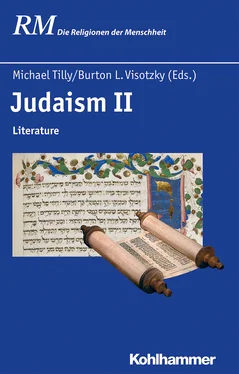1.3 Gaonic Law () and Custom ()
1.3.1 Halakhot Pesuqot and Halakhot Gedolot
1.3.2 Responsa
1.3.3 Saʿadia
1.3.4 Shmuel ben Hofni
1.3.5 Hai ben Sherira
1.3.6 Differing Customs between Babylonian and Palestinian Rabbinic Jews
1.4 Midrash
1.4.1 She’iltot
1.4.2 Ve-hizhir
1.4.3 Tanḥuma literature
1.4.4 Midrash Kohelet Rabbah
1.4.5 Pirqe Rabbi Eliezer and Targum Ps. Jonathan
1.4.6 Seder Eliahu
1.4.7 Midrash Mishle
1.4.8 Avot DeRabbi Natan
1.5 Biblical exegesis
1.5.1 Tafsīr and Commentary
1.5.2 Masoretes
1.5.3 Grammarians
1.6 Philosophy
1.7 Medieval Mysticism
1.8 Piyyut
1.9 Liturgy
1.10 Polemic
1.10.1 Iggeret Rav Sherira
1.10.2 Rabbenu Nissim ibn Shahin and Rabbenu Hananel ben Hushiel of Kairawan, Shmuel ibn Naghrela of Granada
2 Karaite Literature and its Genres (9–11 c.)
2.1 Legal texts
2.2 Exegetical works
2.3 Masorah
2.4 Grammatical tradition
2.5 Philosophical treatises
2.6 Polemical texts
2.7 Homilies and propaganda writings
2.8 Karaite liturgy and piyyutim
3 Conclusions
For Further Reading
Medieval Commentary, Responsa, and Codes Literature
Jonathan S. Milgram
1 Introduction
2 The Geonim
2.1 Commentary of the Geonim
2.2 Responsa Literature of the Geonim
2.3 Codes Literature of the Geonim
3 The Rishonim
3.1 Muslim Spain and North Africa
3.1.1 Commentary in Muslim Spain and North Africa
3.1.2 Responsa from Spain and North Africa (Muslim period)
3.1.3 Codes Literature from Spain and North Africa (Muslim Period)
3.2 Northern Europe
3.2.1 Commentary in Northern Europe
3.2.2 Responsa in Northern Europe
3.2.3 Codes Literature in Northern Europe
3.3 Christian Spain
3.3.1 Commentary in Christian Spain
3.3.2 Responsa of Christian Spain
3.3.3 Codes Literature of Christian Spain
4 The Fifteenth to the Sixteenth Century: R. Joseph Caro and R. Moses Isserles
For Further Reading
Medieval Biblical Commentary and Aggadic Literature
Rachel S. Mikva
1 Biblical Commentary
1.1 From Derash to Peshat
1.1.1 The Emergence of the Northern French School
1.1.2 Rashi (1040–1105)
1.1.3 Rashbam (1080–1160)
1.1.4 Ibn Ezra (c. 1089–1164)
1.2 The Expansion of Meaning
1.2.1 Moses Maimonides and Philosophy (1135–1204)
1.2.2 David Kimḥi and Narrative (1160–1235)
1.2.3 Naḥmanides and Mysticism (1194–1270)
1.2.4 Baḥya ben Asher and Four-fold Exegesis (c. 1255–1340)
2 Aggadic Literature
2.1 Orality and the Open Book
2.2 The »Problem« with Aggadah
2.3 Midrash Reimagined
2.3.1 Midrash-Commentary Hybrids
2.3.2 Halakhah-Aggadah Hybrids
2.3.3 Additional new directions
2.4 Development of Narrative
2.4.1 Narrative Midrash
2.4.2 Minor Midrashim
2.4.3 Absorption of foreign material and original Jewish stories
2.5 Historiography
2.5.1 Apocalypse
2.5.2 Exempla, Hagiography and Martyrology
2.6 Ethical Literature
2.7 Anthologies and Collections
2.7.1 Anthologies
2.7.2 Midrash Rabbah and Medieval Collections
For Further Reading
Piyyut
Elisabeth Hollender
1 Poetic Genres
1.1 Piyyutim for the Shemaʿ
1.2 Piyyutim for the ʿAmidah
1.3 Further Piyyutim
2 History of Piyyut
2.1 Pre-classical Piyyut
2.2 Classical Piyyut
2.3 Post-classical Piyyut
2.4 Andalusian Piyyut
2.5 Italian Piyyut
2.6 Ashkenazic piyyut
2.7 Other Piyyut Traditions
3 Criticism and Rejection of Piyyut
4 Scholarly Research
For Further Reading
Jewish Liturgy
Dalia Marx
1 The History of Jewish Prayer
1.1 Prayer in the Hebrew Bible: Spontaneous personal prayer and Psalms
1.2 Prayer in the Second Temple Period: The root sources of Jewish prayer
1.3 Prayer in the Rabbinic Era: Creation of prayer structure and primary content
1.4 The Babylonian and Palestinian Talmuds and the Midrashic compilations of the Amoraic Era (ca. 220–550 CE)
1.5 Prayer in the Gaonic Era: The First Prayer Books
1.6 The »« Period—Formation of Local Liturgical Customs
1.7 The : Influences of Printing and the Kabbalah upon Jewish Prayer
1.8 Prayer in the Modern Era: from the eighteenth through the mid-twentieth centuries
1.9 Jewish Liturgy from the mid-20 century to today: Modernity and Post-Modernity
2 The Structure of Jewish Liturgy
2.1 The Liturgy of the
The portions of the
The blessings surrounding the
2.2 The ʿAmidah
The Opening
The Middle Benedictions/Blessings
The Closing Benedictions/Blessings
2.3 The Torah Service
2.4 Opening and Conclusion of Prayer
2.5 Sabbath and Festival Prayers
2.6 Home Liturgies
For Further Reading
Jewish Mysticism
Elke Morlok
1 Sources and Major Topics
2 Current Discussion in Research
3 Early Jewish Mysticism
3.1 Mysticism and Literature
3.2 (Measures of Stature)
3.3 (Book of Creation)
4 Medieval Jewish Mysticism and the Rise of Kabbalah
4.1
4.2 Kabbalah in Provence and the
4.3 Kabbalah in Catalonia
4.4 Kabbalah in Castile
4.5 The
4.6 Abraham Abulafia (1240–after 1292)
4.7 Joseph Gikatilla (1248–c. 1305)
4.8 Theosophy and Theurgy
5 Renaissance and Early Modern Times
5.1 14–16 Centuries – Spanish Expulsion to Safed Community
5.2 Isaac Luria, (1534–1572)
5.3 Sabbatai Zevi (1626–1676)
5.4 Jacob Frank (1726–1791)
6 18 Century Kabbalah
6.1 The »Besht« and the Upsurge of Hasidism
7 Kabbalah in the 20 and 21 Centuries
For Further Reading
Index
1 Sources
1.1 Hebrew Bible
Genesis
Exodus
Leviticus
Numbers
Deuteronomy
Joshua
1 Samuel
1 Kings
2 Kings
1 Chronicles
2 Chronicles
Ezra
Nehemiah
Esther
Job
Psalms
Proverbs
Ecclesiastes
Song of Solomon
Isaiah
Jeremiah
Lamentations
Ezekiel
Daniel
1.2 New Testament
1.3 Deuterocanonical Works and Septuagint
1.4 Old Testament Pseudepigrapha
1.5 Dead Sea Scrolls
1.6 Philo of Alexandria
1.7 Flavius Josephus
1.8 Rabbinical Sources
1.9 Classical and Ancient Christian Writings
2 Names
3 Keywords
In the beginning, the Hebrew Bible was formed as an anthology of Jewish texts, each shaping an aspect of Jewish identity. As the Israelite community and its various tribes became two parts: a Diaspora and its complement, the community in the Land of Israel—competing interests formed a canon that represented their various concerns. Over time, the communities grew, interacted, and focused on local religious needs, all the while ostensibly proclaiming fealty to the Jerusalem Temple. Even so, some communities rejected the central shrine that the Torah’s book of Deuteronomy proclaimed to be »the place where the Lord chose for His name to dwell« (Deut. 12:5, et passim). Still other Jewish communities had their own competing shrines. Yet for all their dissentions, disagreements, and local politics, there was a common yet unarticulated core of beliefs and practices that unified the early Jewish communities across the ancient world. 1As the Second Temple period (516 BCE–70 CE) drew to a close, the biblical canon took its final shape, and a world-wide Jewish community—no longer Israelite—emerged as a moral and spiritual power. 2
That canon, by definition, excluded certain Jewish texts, even as it codified others. And the political processes of the Persian and Hellenistic empires confined and defined the polities of their local Jews. From east to west, at the very moment in 70 CE when the centralized Jerusalem cult was reduced to ashes, Judaism, like the mythical phoenix, emerged. Across the oikumene, with each locale finding its own expressions, communities that had formed around the study of the biblical canon produced commentaries, codes, chronicles, commemorations, and compendia about Judaism. Some of these were inscribed on stone, others on parchment and paper, while still others were committed to memory. The devotion to this varied literature helped shape a Jewish culture and history that has persisted for two millennia.
Читать дальше







